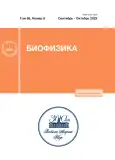Minimal model for the dependence of stresses in the wall of a cerebral vessel on the parameters of a smooth muscle cell
- Autores: Shadrina N.K.1
-
Afiliações:
- Pavlov Institute of Physiology, Russian Academy of Sciences
- Edição: Volume 68, Nº 5 (2023)
- Páginas: 1022-1030
- Seção: Articles
- URL: https://journals.rcsi.science/0006-3029/article/view/233480
- DOI: https://doi.org/10.31857/S000630292305023X
- EDN: https://elibrary.ru/NARCNP
- ID: 233480
Citar
Texto integral
Resumo
Palavras-chave
Sobre autores
N. Shadrina
Pavlov Institute of Physiology, Russian Academy of Sciences
Email: nkhsh@yandex.ru
Saint-Petersburg, Russia
Bibliografia
- И.В. Гончар, С.А. Балашов, И.А. Валиев и др., Труды МФТИ, 9 (1), 101 (2017).
- N. R. Tykocki, E. M. Boerman, and W. F. Jackson, Compr. Physiol., 7 (2), 485 (2018). doi: 10.1002/cphy.c160011
- W. F. Jackson, Front. Physiol., 12, 770450 (2021). doi: 10.3389/fphys.2021.770450
- H. Chen and G. S. Kassab, Sci. Rep., 7 (1), 9339 (2017). doi: 10.1038/s41598-017-08748-7
- Y. Lu, J. Wu, Y. Li, et al., Sci. Rep., 7 (1), 13911 (2017). doi: 10.1038/s41598-017-14276-1
- K. Takamizawa, Cardiovasc. Eng. Tech., 10 (4), 604 (2019). doi: 10.1007/s13239-019-00434-1
- A. Rachev and K. Hayashi, Ann. Biomed. Eng. 27, 459 (1999). doi: 10.1114/1.19
- M. A. Zulliger, A. Rachev, and N. Stergiopulos, Am. J. Physiol. Heart Circ. Physiol., 287, H1335 (2004). doi: 10.1152/ajpheart.00094.2004
- B. Zhou, A. Rachev, N. Shazly, J. Mech. Behav. Biomed. Mater., 48, 28 (2015). doi: 10.1016/j.jmbbm.2015.04.004
- M. Bol, A. Schmitz, G. Nowak, and T. Siebert, J. Mech. Behav. Biomed. Mater., 13, 215 (2012). doi: 10.1016/j.jtbi.2011.11.012
- K. Uhlmann and D. Balzani, Biomech. Model. Mechanobiol., 22, 1049 (2023). doi: 10.1007/s10237-023-01700-x
- С. А. Регирер, И. М. Руткевич и П. И Усик, Механика полимеров, № 4, 585 (1975).
- S. Murtada, A. Arner, and G. A. Holzapfel, J. Theor. Biol., 297, 176 (2012). doi: 10.1016/j.jtbi.2011.11.012
- S. Murtada and G. A. Holzapfel, J. Theor. Biol., 358 (7), 1 (2014). doi: 10.1016/j.jtbi.2014.04.028
- A. Navarrete, P. Varela, M. L6pez, et al., Front. Bioeng. Biotechnol., 10, 924019 (2022). doi: 10.3389/fbioe.2022.924019
- C. Hai, and R. A. Murphy, Am. J. Physiol., 255, 86 (1988).
- J. Stalhand and G. A. Holzapfel, J. Theor. Biol., 397, 13 (2016). doi: 10.1016/j.jtbi.2016.02.028
- J. Yang, J. W. Clark, R. M. Bryan, and C. A. Robertson, Med. Engineer. & Physics, 25, 691 (2003). doi: 10.1016/s1350-4533(03)00100-0
- J. Yang, J. W. Clark, R. M. Bryan, and C. A. Robertson, Med. Engineer. & Physics, 25, 711 (2003). doi: 10.1016/s1350-4533(03)00101-2
- M. Koenigsberger, R. Sauser, D. Seppey, et al., Bophys. J., 95 (6), 2728 (2008). doi: 10.1529/biophysj.108.131136
- A. Coccarelli, D. H. Edwards, A. Aggarwal, et al., J. Roy. Soc.Interface, 15, 20170732 (2018). doi: 10.1098/rsif.2017.0732
- Н. Х. Шадрина, Биофизика, 66 (1), 157 (2021).
- H. J. Knot and M. T. Nelson, J. Physiol., 508 (1), 199 (1998). doi: 10.1111/j.1469-7793.1998.199br.x
- G. Gabella, J. Ultrastruct. Res., 84 (1), 24 (1983). doi: 10.1016/s0022-5320(83)90083-7
- G. E. Sleek and B. R. Duling, Circ. Res., 59, 620 (1986). doi: 10.1161/01.res.59.6.620
- Y. Fung, Biomechanics (Springer-Verlag, N.-Y., 1981).
- Н. Х. Шадрина, Изв. РАН. Мех. жидк. и газа, № 2, 3 (2020). doi: 10.31857/S0568528120020115
- G. Osol, J. F. Brekke, K. McElroy-Yaggy, and N. I. Gokina, Am. J. Physiol. Heart Circ. Physiol., 283, H2260 (2002). doi: 10.1152/ajpheart.00634.2002
- R. Sanft, A. Power, and C. Nicholson, Math. Biosci., 315, 108223 (2019). doi: 10.1016/j.mbs.2019.108223
- A. Arner, Eur. J. Physiol., 395, 277 (1982). doi: 10.1007/BF00580790.
- H. J. Knot, N. B. Standen, and M. T. Nelson, J. Physiol., 508 (1), 211 (1998). doi: 10.1111/j.1469-7793.1998.211br.x
Arquivos suplementares









